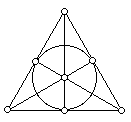Course MT3818 Topics in Geometry
The projective space of a vector space
Given any vector space V over a field F, we can form its associated projective space P(V) by using the construction above.
P(V) = V - {0}/~ where ~ is the equivalence relation u ~ v if u = λv for u, v ∈ V - {0} and λ ∈ F.
Examples
- With this definition RP1= P(R2) and RP2= P(R3) so one needs to be careful about dimensions.
- Let V be vector space C2 over the complex numbers C. Then P(C2) is the complex projective line CP1 which (arguing as in the real case) consists of C together with a single point at infinity.
Topologically, this is the Riemann sphere S2.
- Let V be a vector space over a finite field F. Such a finite field has pk elements where p is a prime number. Then if V has dimension n over F, we have |V - {0}| = pkn - 1 and since each line through 0 in this has pk - 1 elements on it we get |P(V)| = (pkn - 1)/(pk - 1).
- For any finite field, with n = 2 we get a projective line with |F| + 1 points consisting of F together with one extra point.

- If |F| = 2 and n = 3 we get a projective plane with 7 points.
The points lie in 3's on 7 lines and each point is the intersection of 3 lines.
Every pair of points determines a line and every pair of lines meet in a unique point.
(One of the lines is represented by a circle on the picture.)
- If |F| = 3 and n = 3 we get a projective plane with 13 points.
The points lie in 4's on 13 lines and each point is the intersection of 4 lines.
Once again every pair of points determines a line and every pair of lines meet in a unique point.
Examples like these last two are very interesting combinatorial objects and have many nice properties.
JOC March 2003
